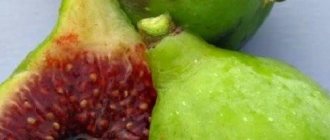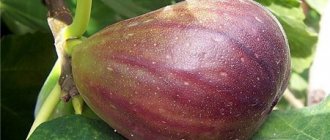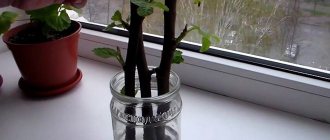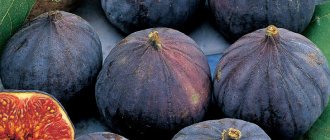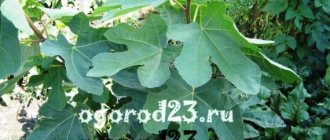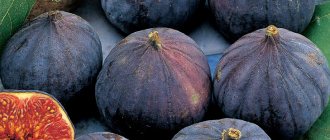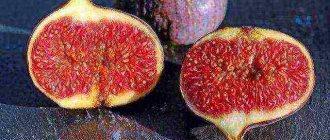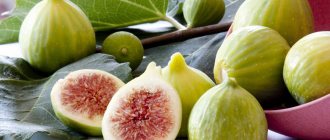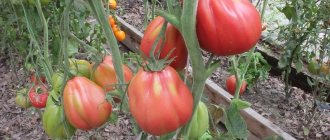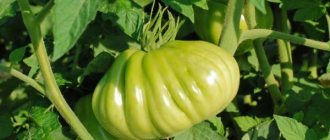When planting a garden on a personal plot, a wide variety of fruit crops are planted. In addition to apple and pear trees, exotic plants are often grown, such as lemon, peach, apricot, fig, which is also called the fig tree and fig tree. The fig is quite whimsical, but if favorable conditions are created, it will grow and bear fruit for a long time.
This is what fig fruits look like
What does a fig look like?
Figs are a heat-loving, subtropical plant 8-10 meters high. The wide crown is formed by thick branches with light gray smooth bark. The lobed large leaves are dark olive in color. The leaf plate is attached to the shoots using a thick cutting.
The pear-shaped fruits are sweet, juicy, weighing about 70 g. The thick peel is yellow, lemon-olive and dark blue. Inside the fruit are small seeds-nuts. The color and size of figs depends on the region of growth and variety. Unripe figs are green in color.
Note! During the growth period, the fig tree often blooms. Male flowers appear from spring to autumn, and female flowers only in summer and autumn.
Gardeners often argue about what a fig is - a fruit, a vegetable or a berry. According to the botanical statement, it is neither one nor the other, since the edible part of the tree is the ripe flower, so it is correct to call it the fruit. The confusion stems from the names “wineberry” or “fig” fruit.
Where do figs grow?
Figs are a heat-loving tree, therefore they grow in Mediterranean countries, the Carpathians, Crimea, Central Asia, and the Caucasus. In central Russia, shrubby, frost-resistant species are grown.
Heat-loving plant fig
What is useful, characteristics
The fruits of the fig tree are tasty and healthy. The pulp contains potassium, which improves the functioning of the heart muscle. The fruits also contain a blood-thinning substance, so figs are good to take as a prevention of thrombosis. Fig will help with anemia, urinary tract diseases, and stop the growth of cancer cells.
If you boil the fruits in milk and drink 100 ml of the drink 3 times a day, you can quickly cure diseases of the upper respiratory tract. Fig jam improves metabolism and digestion.
Important! Fig juice relieves acne, heals wounds, and in complex treatment eliminates skin cancer.
Application
The collected fruits are dried in the open air and eaten raw. They make fig jam, liqueurs and wines. Used as a filling in pies. Dried fruits are crushed and used as an additive in dishes.
The use of fruits in medicine is very popular. They treat diseases of the bronchi and lungs, and are used for anemia, since the fruit contains a large amount of iron. It supports the functioning of the heart and blood vessels, containing a sufficient amount of potassium and magnesium.
It has an antipyretic effect when consumed in decoctions. Effectively treats cough. The juice of unripe fruits is used in the treatment of warts and in the preparation of hair removal creams. And for cosmetic purposes.
The leaves are used in the treatment of skin diseases: furunculosis, vitiligo and wound healing. The fruits are very well digestible, fill you with energy and relieve fatigue.
Growing figs at home - tips and instructions for care and maintenance indoors (155 photos and videos)
- Norway spruce - general information, description, properties, characteristics and cultivation features. 105 photos of using spruce in landscape design
Why cherry trees dry out after flowering - searching for the reason and tips on how to save the tree and harvest (125 photos)
Popular fig tree varieties
Fig tree or fig tree how to grow at home
Several varieties can be grown in the garden. But before purchasing a seedling, it is important to familiarize yourself with the external characteristics, learn how figs grow, as well as the growing conditions.
Variety Brunswick
Cold-resistant variety, can withstand frosts down to -27 degrees. Therefore, it is often grown in Russia. After a severe winter, the variety quickly recovers, sprouting new young basal shoots.
Variety Brunswick
In regions with a warm climate, the plant reaches a height of up to 2 m, but in Russia such a height is not acceptable. The lobed foliage is large and is held on the shoot by thick stems. The flowers are inconspicuous, male flowers appear from spring to autumn, female flowers only in summer and autumn.
The variety begins to bear fruit 2 years after planting in July and September. During the first fruiting, the variety produces a few fruits weighing 100 g; in the fall, the harvest is richer, but the fruits weigh 70 g.
Important! In central Russia, figs bear fruit once, since the second crop does not have time to ripen due to the early onset of winter.
Variety Kadota
Self-pollinating variety bred in California. The variety begins to bear fruit early. Pear-shaped, greenish-yellow fruits are sweet, weighing 60 g. Ripe figs have a strong aroma and rich taste.
Yellow figs prefer to grow in an open, sunny location. The tree must be covered for the winter.
Kadota
Crimean black
The popular variety grows in regions with warm climates and is found in the Crimea. It is often grown in bush form, although in nature it is a large spreading tree. The variety is self-fertile, mid-season, bears fruit twice a year.
The first harvest appears in July, the fruits are large, weighing 80 g. The second wave occurs in September - the fruits grow small, weighing 40 g. Ripe figs have a pear shape, a dense dark-gray peel with a purple tint, a sweet, juicy dark crimson or deep red pulp. The fruits are suitable for making homemade preparations and dried fruits.
Crimean black
Dalmatian
The variety was bred in 1901 by Tbilisi breeders. In Russia it can be found in the Black Sea zone. The variety is self-fertile and can withstand frosts down to -15 degrees.
The first fig harvest season is early June. From 20 to 35 fruits weighing 180 g appear on the tree. The second wave is more abundant and occurs in the fall, but the weight of the fruit does not exceed 90 g. The greenish or yellow fruits have a flattened pear-shaped shape with an expanded apex. The pulp is juicy and sweet, dark crimson in color.
Dalmatian
Photo of figs
Many people know what dried figs look like, because... in this form it goes on sale in Russia and other countries. Photos and information about what the tree, its seeds and flowers look like will help you learn many interesting facts about this plant.
Tree (bush)
In the Mediterranean countries and Asia, wild fig trees grow to large sizes under favorable conditions. The plant consists of one (up to 18 cm in diameter) or many trunks fused together, and can reach a height of 10-12 m. The extensive and spreading crown further increases its size.
In countries located closer to the north (Georgia, Uzbekistan, Azerbaijan, etc.), figs grow as a shrub with a maximum height of up to 8 m.
Several specially bred varieties of fig trees are used for indoor growing. At home, this plant looks like a small bush. Caring for it is carried out similarly to decorative ficuses, of which figs are relatives.
Fresh fruit
Fig fruits are pear-shaped, slightly elongated or spherical, their size can reach 10 cm. They are small in size and easily fit in the human palm. The outside of the figs are covered with a hairy skin, and at the top there is an “eye” - a hole covered with scales.
The color and shape of figs are varied and depend on the variety:
- black figs have a black-purple skin and red flesh;
- white figs have a thicker and lighter skin, the flesh is honey-yellow or red;
- yellow-green varieties have red, sweet flesh inside.
Each fruit contains up to 16 thousand tiny grains or about 30 larger ones.
Dried fruit
Various dried fruits are in demand among the population in the autumn-winter period; they can be found on the shelves of supermarkets and markets. Dry figs are brought to Russia from hot countries. It can be eaten alone or added to cottage cheese, yogurt and fruit salads, baked goods and meat dishes.
When choosing dried fig fruits, it is recommended to pay attention to their appearance:
- the shape of dried fruits should be flattened;
- fruit color - beige or light brown, matte;
- on some, the presence of a white coating, which consists of escaping glucose, is acceptable;
- Experts do not recommend taking crushed fruits or fruits with spots on the skin;
- The fruits should be soft to the touch; their hardness indicates overdrying.
We recommend that you read Little tangerines
Colors
Ancient people claimed that no one gets to see a fig tree bloom. Therefore, in China the plant is called “uh-wa-go”, which means “fruits without flowers”. However, they were mistaken.
Scientists have proven that it is difficult to see figs blooming because... the flowers are located inside pear-shaped inflorescences called syconiums. Such flowers look like small hollow balls, which are stored in pear-shaped syconiums. And there are tiny holes at the top of them. The first inflorescences appear in the spring, growing from the axils of young shoots.
Semyan
The photos above show that the seeds of figs are small (1-2 mm) and look like tiny nuts. For those who want to grow a fig tree in their home, seed material can be obtained directly from ripened fresh fruits. When dried, seeds can be stored for 2 years without losing their viability.
Growing figs from seeds is a long and labor-intensive task. You have to wait 2-8 weeks for soaked grains to peck (if they are kept in a warm room with a temperature of +25...+27°C). During the growing season, the plant needs warmth and sunlight, so in summer it is better to place it on the south side of the balcony and water it abundantly. The decorative fig can begin to bear fruit only in 4-5 years.
In the context
If you cut a fresh fig fruit, you can see numerous small grains - the more of them, the tastier the fruit will be.
Preparing figs for planting in open ground
It is better to purchase a fig tree seedling at 2 years of age with a pair of side shoots. The older the plant, the worse it takes root. When purchasing, you should pay attention to the root system: it should be free of damage and signs of disease. The trunk should have smooth bark and several healthy buds.
When can you plant
Tangerine tree - care at home
Since figs are a heat-loving plant, seedlings are planted in the spring so that they have time to take root during the warm period and safely survive the first cold weather. Experienced gardeners recommend planting a fig tree in the second half of March, when the snow melts and warming begins.
Site selection and soil preparation
In order for figs to grow and bear fruit well, it is important to choose the right place for planting. It must meet the following criteria:
- located on the south side of the site;
- there should be no buildings or tall trees nearby that block the view;
- groundwater location no more than 2.5-3 meters;
- the place should be protected from gusty winds.
Important! Figs prefer well-drained, fertile soil with neutral acidity. If the soil is acidic, it is deoxidized with dolomite flour or wood ash.
Growing a fig tree in open ground
Sea buckthorn is a tree or shrub; growing sea buckthorn at home
Growing a fig tree is beyond the capabilities of a novice gardener. Since when growing figs in open ground, care and pruning are necessary.
How to plant a plant correctly
You can plant the purchased seedling in 2 ways: at an acute angle and with the formation of a horizontal cordon. The first method makes it easier to bend the branches in front of the shelter. When using the second, the seedling is installed vertically after trimming the top. The side shoots bend to the ground and go in different directions. Buds form on them, and then branches, on which the fig crop subsequently ripens.
Planting a seedling
Step-by-step instruction
In order for the fig tree to grow and develop well, it is important to follow the planting rules. Step-by-step instruction:
- At the chosen location, you need to dig a planting hole measuring 80x80 cm, 1 meter deep.
- The root system of figs quickly expands. Therefore, in order for the plant to grow upward, the walls of the hole must be tightly lined with bricks.
- Drainage is laid out at the bottom with a layer of 20-30 cm.
- Part of the nutrient soil is laid out on the drainage.
- The seedling is installed in the hole at an angle of 40 degrees - this will make it easier to bend the branches before covering for the winter.
- The roots are covered with earth. The top layer is compacted and spilled. For one specimen you need to use at least 4 liters of warm, settled water.
- To retain moisture and stop the growth of weeds, the tree trunk circle should be mulched.
All about figs
Figs - what kind of plant is this? This is a deciduous crop that belongs to the genus Ficus.
Which family does it belong to?
Fig tree or fig - description of what the fruit looks like
Figs belong to the Mulberry family. This plant is one of the oldest cultivated plants. It was first grown in Arabia, then in Phenicia, and then until now in Syria and Egypt.
What does he look like
The fig tree is a large plant that grows up to 8-10 m. The bark of the fig plant is light and smooth. The diameter of the column can reach up to 18 cm. The roots grow up to 15 m in width and up to 6 m in length.
Fig leaves
Fig leaves are large in size. They can be dark green to grayish green in color. The leaf grows up to 15 cm in length and up to 12 cm in width. They are alternate, three, five, seven pollen-lobed or separate and rigid with falling stipules.
Short shoots grow in the axils of the leaves. They contain inflorescences of two types. The first ones are called caprifigs, and the second ones are called figs. They grow on various trees. Their axis grows until they form a ball with a hole at the top. They are hollow inside. Dioecious flowers develop there.
Fig fruit
Figs grow into juicy and sweet fruit. They are pear-shaped and have many seeds inside. Fig fruits are covered with thin skin. There are numerous hairs on it. There is a hole on top of the fruit that is covered with scales. The fruit can range from black-blue to yellowish.
For your information! Fresh fruits contain up to 24% sugars, and dried ones up to 37%.
How to care for figs in the garden
For good fruiting, it is important to carry out careful care, as well as to know what a fig tree is and why figs fall off. Otherwise, the fig tree will develop poorly, various diseases will appear and the plant will die.
Fertilizer application
The fig tree is fed at least 3 times a year. Fertilizers are applied only after abundant watering, otherwise the plant will get root burns. Feeding rules:
- the first nitrogenous fertilizing is needed at the beginning of the growing season;
- in mid-summer, phosphorus fertilizers are applied, diluted strictly according to the instructions. They promote the formation of fruits;
- At the end of the growing season, the tree is fed with potassium fertilizers. They will help the figs ripen faster.
Important! The fig tree will not refuse foliar feeding. It is recommended to do it 2 times a month.
Do I need to water and how much?
The frequency of watering depends on the age of the plant. Young seedlings are watered daily. Water consumption for each tree is from 5 to 10 liters. Next year, when the root system is formed, watering should be reduced to 2 times a week.
During the period of fruit appearance, watering stops completely. The last time the soil is moistened is after harvesting. To prevent the formation of an earthen crust, loosen the soil and mulch.
Watering with warm water
Pruning and shaping the bush
In order for figs to maintain their decorative appearance, it is important to prune them in a timely manner. In the south this is done in spring and autumn. When grown as a shrub, in the first 2 years it is necessary to leave 2 main branches 40 cm long. A standard tree is formed from 3-4 main branches 60 cm long. To prevent infection, the cut site should be covered with garden varnish. Fig pruning:
- In the first year after planting, the strongest main branch is left, the rest are cut off.
- After a year, the top is shortened by 1 bud.
- In the 3rd year, skeletal side shoots should be shortened by ½ length.
Further pruning is not carried out, with the exception of branches growing inside the crown. All root shoots should be removed in a timely manner, otherwise the figs will not grow upward, but in width.
How and where figs grow and bloom
Fig trees are divided into male and female. Pollination is carried out by black blastophagous wasps. The inflorescences have small holes through which pollination occurs. Edible fruits grow only on female representatives. Fig fruits are shaped like a pear. They can reach up to 10 cm in length.
Note! Unripe fruits cannot be eaten. This is due to the fact that they contain latex, which is harmful to the body.
A ripe fruit contains from 30 to 1600 seeds. If growing conditions are favorable, a fig tree can bear fruit for 200 years. Flowering can occur several times a year. Fruit set occurs at the end of the warm season from summer to autumn.
The fig tree was first cultivated 5,000 years ago. Its homeland is Saudi Arabia. There it is widely used in the food and medical industries. Over time, the fig tree began to spread throughout Europe and the Canary Islands. Around 1530 the fruits were tasted in England. The seeds were then transported to South Africa, Australia, Japan, China and India. In 1560, the fig tree began to be grown in the USA and Mexico. Figs are also common in the Caucasus (Georgia, Armenia, Azerbaijan). It is grown on a large scale in Turkey, Greece, Italy and Portugal.
In Russia, the fig tree grows on the black coast in the Krasnodar region and on the island of Crimea. It has been growing there since ancient times. The fig tree bears fruit where the climate is warm and dry.
Figs are the oldest plant
The best varieties of figs for the Middle Zone
The varieties of wine berries that grow best in the conditions of the Middle Zone include:
- Crimean black. Has an average ripening period;
- Dalmatian. Bears fruit twice a year;
- early gray The fruits ripen early;
- Randino. Fruits twice a year.
Note! The ripening time of figs depends on the conditions and region of growth. The fruits ripen in two stages. On average, this happens for the first time in June, and the second time in September and October.
Ripe fruits increase greatly in size and have a bright color. Nectar droplets appear on the peel.
Fig tree propagation
The fig tree can be propagated by seeds, cuttings, root shoots and offsets. The simplest methods are cuttings and propagation by cuttings.
Seed propagation
It is difficult to propagate figs by seeds, so this method is not suitable for novice gardeners. The seeds are pre-germinated at home. For this:
- At the beginning of spring, planting material is planted in nutritious, moist soil to a depth of 3 cm.
- Before emergence, the container is covered with polyethylene to create a favorable microclimate.
- The strengthened sprouts are transplanted into separate containers.
- Caring for seedlings involves regular watering.
- The seedling is planted in the prepared place at the age of 2 years.
By layering
You should choose a strong, healthy branch that is located close to the ground and place it in a pre-dug trench. Sprinkle the shoot with soil so that the top remains above the surface. Compact the soil and water it abundantly. After new leaves appear on the shoot, it must be dug up and transplanted to the chosen location.
Reproduction by layering
By cuttings
Figs can be propagated from green and woody cuttings. Green cuttings are cut immediately before rooting. A well-ripened lower branch with 3-4 buds is suitable for this. The planting material is cut 10-15 cm long. The upper cut is made straight, the lower cut is oblique, and several longitudinal furrows are cut above it. For rapid root formation, it is recommended to place the cuttings in a Heteroauxin solution for 12 hours.
Next, the lower cut should be sprinkled with ash and the cutting should be buried at an angle into the nutrient soil. Water the planting material and cover with a jar. After the leaves appear, the cover must be removed and the container moved to a warm place. If agricultural practices are followed, rooting will occur within 30 days.
Root shoots
A simple way to propagate low-growing varieties. You need to carefully dig up the root, separate it from the mother bush and plant it in a sunny place.
How figs bloom and bear fruit
In the axils of the leaves there are pear-shaped inflorescences - syconia with a small hole at the top. This hole is intended for blastophagous wasps that pollinate the tree. Male flowers are called caprifigs, female flowers are called figs. Figs ripen 2 years after planting.
Fig blossom
When do figs ripen?
The first wave of fruiting occurs in June. The harvest is not large, but the fruits are large. The second comes in September. During this period, the tree produces a generous harvest, but with small fruits.
How to feed figs during fruiting
During fruiting, the fig tree is not watered. For good formation and ripening of fruits, figs are fed with phosphorus and potassium fertilizers. In order not to harm the plant, fertilizers are applied and diluted strictly according to the instructions.
Common fig
Feijoa is a fruit or berry - where it grows and what it looks like
The common fig is a woody plant. It looks like a shrub or woody tree. Its leaves are large and whole. Cultivated species are a full-fledged tree that can grow to a height of 4 m or more. A distinctive feature of the plant is that its flowers are dioecious. Women's ones have the shape of a ball, pear or flattened shape. There is a small hole at the top. When the flowers are pollinated, many fruits appear. They are nuts that are surrounded by juicy pulp. The color of the fruit can range from yellow to dark. A yellowish-green tint is common.
What does a fresh fig tree look like?
White figs
White figs have thicker skin. Its flesh is yellow or red. Wine berries with yellow pulp are more tasty. It is consumed dried and also boiled in the form of jam.
Problems of growing in open ground, diseases and pests
Beginning gardeners often have difficulty growing figs. The tree grows poorly, does not bear fruit, and drops flowers and fruits. Such problems arise if fungal diseases and insect pests appear on it.
Why do figs drop their fruits before they are ripe?
A fig tree loses its fruit if fungal diseases appear on it, such as:
- gray rot - a gray coating with watery spots appears on the fruits;
- anthracnose - the skin becomes covered with dark spots, the fruits wither and crumble;
- mosaic - the fungus affects the entire aerial part, causing deformity of the fruits and their falling off.
Why doesn't the tree bear fruit?
When growing a fig tree, novice gardeners are faced with the fact that the tree does not bear fruit. This is due to the appearance of insect pests:
- moth - settles in the flowers of the plant, as a result they fall off and the fruits are not set;
- leaf roller - affects the entire aerial part. Without treatment, the tree weakens and there is no flowering;
- psyllid – slows down the development of the plant;
- pine beetle - feeds on bark, which is why the tree quickly dies.
The fig tree is a heat-loving plant that grows in regions with hot climates. But if you choose a frost-resistant variety, this crop can be grown in central Russia. By following the rules of care and cultivation in open ground, as well as by regular pruning, you can achieve a good harvest and enjoy sweet, healthy fruits.
Interesting facts about figs
There are some interesting facts associated with figs:
- There is an opinion that the fig peach fruit is a hybrid of a fig and a peach. However, in reality this is not the case. Fig peach is obtained from wild varieties of peach trees;
- According to many scientists, Adam and Eve ate the forbidden fruit not of an apple, but of a fig, since according to the Bible they covered the nakedness of their bodies with fig trees. The opinion about the use of the apple is due to the fact that it is more famous than the southern fruit;
- the fig tree is a long-lived tree, as it can bear rafts for several hundred years;
- A. Makedonsky took wine berries on military campaigns, as they quickly restored strength;
- Fig trees can grow in the most unfavorable soils. It can even grow on rocks, as long as there is a place where the roots can catch on. A fig tree can even be grown in a flower pot. The main condition for successful growth is the absence of frost;
- Fig tree flowers are not particularly attractive. They are small, ball-shaped, and have a hole at the top;
- Fig tree fruits have a unique composition. They are used to treat dozens of diseases. They are especially used to treat cough and constipation;
- Wine berries contain a huge amount of tryptophan. This substance has a beneficial effect on brain activity. It also normalizes the nervous system, improves sleep, and helps get out of a depressive state. Tryptophan is a source of good mood;
- Figs have an unusually delicate aroma. It is used not only as a medicine, but also as a filling for pies, marmalade and jam, sauces and desserts.
Important! The fig tree is a unique plant. Its fruits have many beneficial properties for both men and women. It is consumed both raw and as dried fruit.
